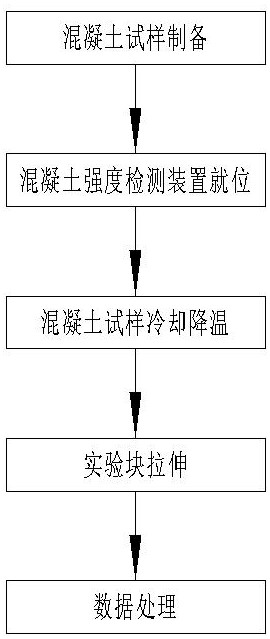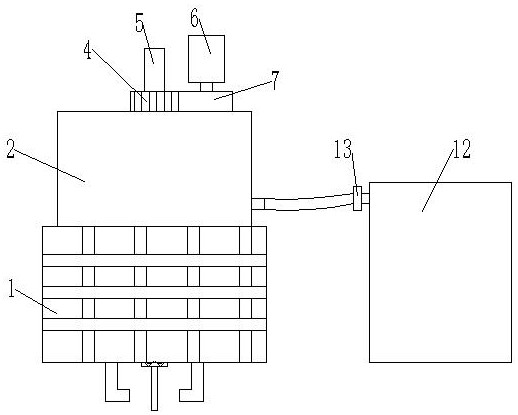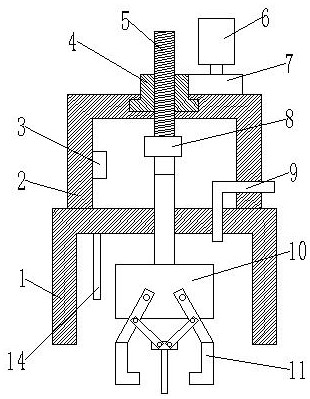Method for detecting setting strength of concrete in low-temperature environment
A concrete strength and strength detection technology, which is applied in the direction of strength characteristics, the use of stable tension/pressure test material strength, and measuring devices, can solve problems such as methods without concrete strength, achieve short time consumption, improve experimental efficiency, and improve The effect of the experimental effect
- Summary
- Abstract
- Description
- Claims
- Application Information
AI Technical Summary
Problems solved by technology
Method used
Image
Examples
Embodiment 1
[0052] see figure 1 , a concrete coagulation strength detection method under low temperature environment, described method comprises the following steps:
[0053] S1: Concrete sample preparation, the concrete sample is ground and processed, and prepared into a test block that meets the requirements, which is convenient for subsequent clamping and testing;
[0054] S2: The concrete strength detection device is in place, place the concrete strength detection device above the concrete sample, and align the clamping mechanism with the test block;
[0055] S3: Cool down the concrete sample, pass the cooling medium into the concrete strength testing device, and cool down the concrete;
[0056] S4: The test block is stretched. When the concrete sample reaches a certain temperature, the concrete strength detection device is started to detect the tensile fracture of the test block;
[0057] S5: Data processing. When the experimental block breaks, record the data of the tension sensor...
Embodiment 2
[0065] see Figure 2-8 , a concrete coagulation strength detection device, comprising: a base 1; the outer surface of the base 1 is provided with ribs, the strength of the base 1 is increased by arranging the ribs, and the upper side of the base 1 is provided with a support 2; The support member 2 is provided with a rotating mechanism 4; the rotating mechanism 4 is connected with the transmission structure 7; the transmission mechanism 7 is connected with the power mechanism 6, and the power mechanism 6 drives the transmission mechanism 7 to rotate; There is a lifting mechanism 5; the lifting mechanism 5 runs through the support member 2 and the base 1, and when the rotating mechanism 4 rotates, the lifting mechanism 5 can move up and down; the lower end of the lifting mechanism 5 is provided with a square plate 10; A clamping mechanism 11 is provided, and the clamping mechanism 11 is used to clamp the concrete sample 15; the lifting mechanism 5 is provided with a tension sens...
Embodiment 3
[0077] The difference from Embodiment 1 is that during the concrete measurement process, in order to allow the concrete to be fully cooled, the volume V inside the base, the thickness D of the base plate, and the thickness d of the cold insulation layer satisfy the following relationship:
[0078] d =α·V / D+M;
[0079] Among them, the unit of D and d is cm; α is the correlation coefficient, the value range is 0.005-0.025, and the unit of V is cm 3 ; M is the compensation parameter, the value is 1-3. When α is less than 0.005, the thickness of the cold insulation layer is low, the cold insulation effect is poor, and the cooling time is long; when α is greater than 0.025, the thickness of the cold insulation layer is larger, and the temperature in the base 1 is lower. When cooling the concrete sample 15, If the device is kept at low temperature for a long time, the material of the device becomes brittle, which reduces the strength of the device, and the device is prone to damage...
PUM
| Property | Measurement | Unit |
|---|---|---|
| Hardness | aaaaa | aaaaa |
| Hardness | aaaaa | aaaaa |
Abstract
Description
Claims
Application Information
 Login to View More
Login to View More - R&D
- Intellectual Property
- Life Sciences
- Materials
- Tech Scout
- Unparalleled Data Quality
- Higher Quality Content
- 60% Fewer Hallucinations
Browse by: Latest US Patents, China's latest patents, Technical Efficacy Thesaurus, Application Domain, Technology Topic, Popular Technical Reports.
© 2025 PatSnap. All rights reserved.Legal|Privacy policy|Modern Slavery Act Transparency Statement|Sitemap|About US| Contact US: help@patsnap.com



